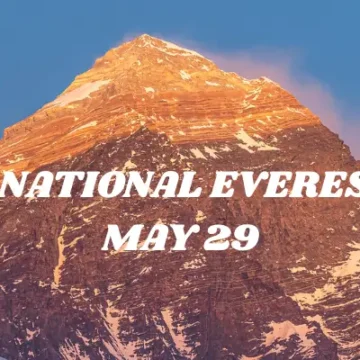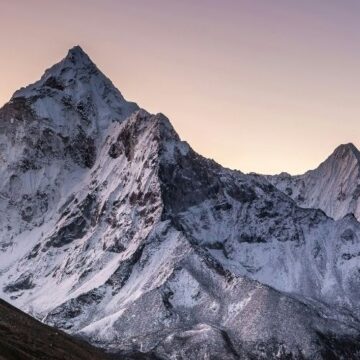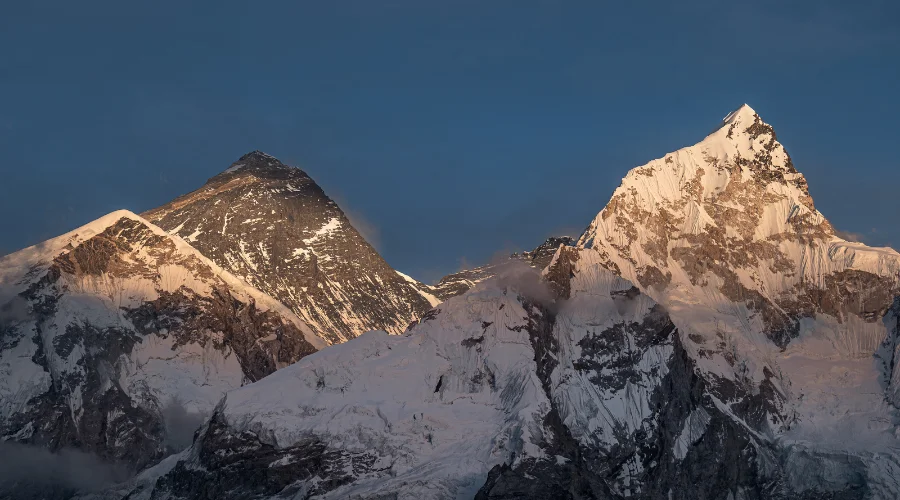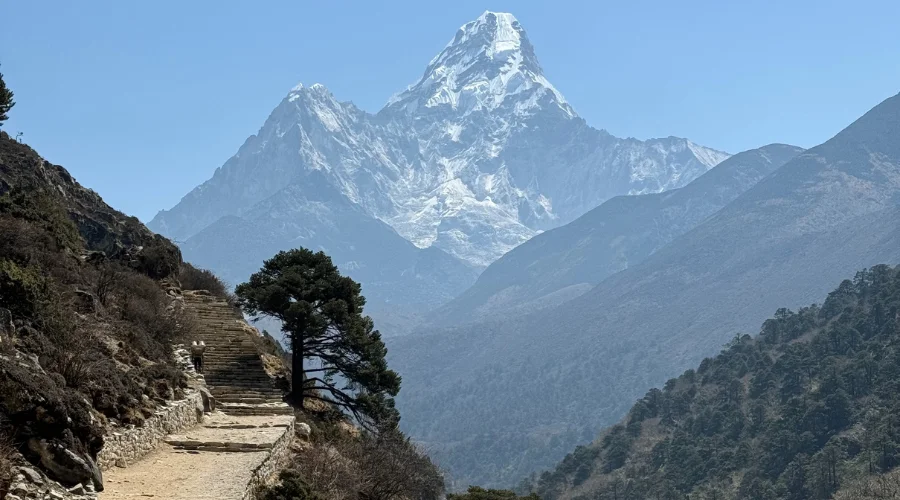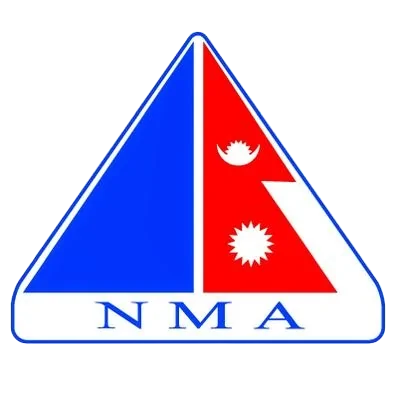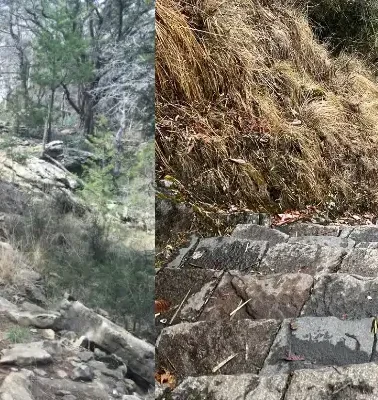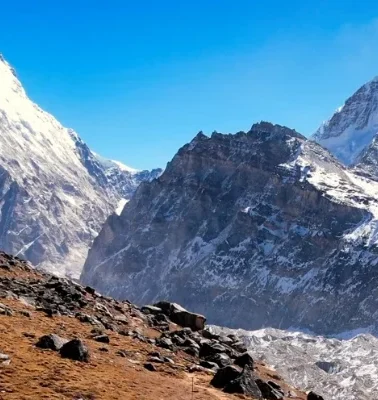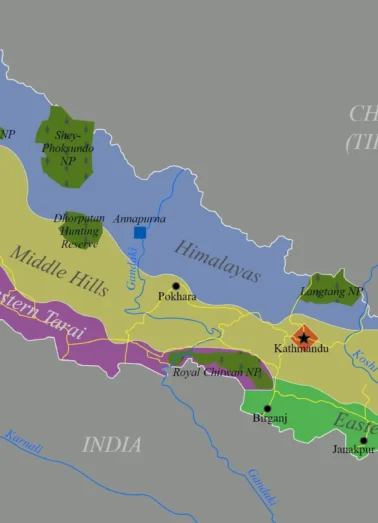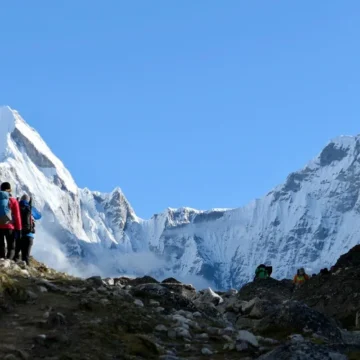

- TRIP DURATION
- 09 Days
- MAX. ALTITUDE
- Kala Patthar (5,550 m)
- TRIP GRADE
- Moderate
- LODGING
- Hotel and Tea House
- BEST SEASON
- Spring and Autumn
- MEALS
- Breakfast, Lunch & Dinner
- COMMUNICATION
- Wi-Fi/Local SIM Card
- PER DAY WALK
- 5 to 6 Hours
Everest Base Camp Trek With Helicopter Return
The first thing that comes into everyone’s mind when they think of Everest Base Camp is the major iconic trek. Many people achieve success and happiness once they reach Everest Base Camp, located at a height of 5,364 meters.
Nowadays, people prefer to enjoy nature and enjoy some convenience. An Everest Base Camp trek with a helicopter return is the best option for such people. Think of how easy and nice it will be to trek all the way to the Everest Base Camp Trek with Helicopter Return.
Overview of Everest Base Camp Trek with Helicopter Return
Everest Base Camp Trek with helicopter return is the best alternative for trekking in the Himalayas. What makes this even more convenient is that if you have any health-related problems, such as altitude sickness, physical challenges, and many more, you can easily fly back with the help of a helicopter.
The Everest Base Camp Trek with helicopter back starts with a thrilling flight to Lukla, the starting point of the Everest Base Camp trek. Then, you will walk along some of the most beautiful villages like Lukla, Namche Bazaar, Dingboche, Lobuche, and much more.
You will also have an aerial return, which means you will have magnificent views of 8,000-meter-high peaks, including Pumori, Lhotse, Nuptse, Lobuche, and Mt. Everest.
Since you won’t be able to have a clear, massive view of Mount Everest from the Everest Base Camp, you can trek (optional) to Kala Pathhar to have an up-close view of Mount Everest.
You will see the world’s highest mountain standing in front of you, along with another eight thousand meters of mountains like Lhotse. Other prominent views of Nuptse, Pumori, and Changste, as well as views of Khumbu Glacier, get you surrounded.
After a memorable sunrise view from Kala Patthar, you’ll return to Gorakshep for the best Everest Base Camp Trek. Then, you’ll take a helicopter ride back to Lukla and catch a flight back to Kathmandu. Experience the best Everest region with our Everest base camp trek return by helicopter option.
The 9-day Everest Base Camp Trek with Helicopter Return will amaze you with a flyout from Everest Base Camp to Lukla. Certainly, this will save you the energy and time you will need for the return trek.
The Everest Base Camp trek will help you immerse yourself in the local culture and see the breathtaking views of the mountains en route to the trek. Along the way, the Sherpa culture will make you realise how challenging and peaceful it is to reside in such a commercialized yet remote area.
Himalayan Masters stands out as the best trekking company for Everest Base Camp Trekking with Helicopter Return. Please check out our detailed day-to-day itinerary to match your expectations and choices.
Everest Base Camp Trek with Helicopter Return Facts
- Duration: 9 Days
- Trip Starting/ Ending Point: Kathmandu (1400 meters/4593 ft)
- Trek beginning point: Lukla Airport (2840 meters/9317.6 ft)
- Trek ending point: Gorakshep (5140 meters/16863.5 ft)
- Highest altitude: 5364 m/17598.5 ft (EBC) or 5550 m/18209 ft (Kala Pathhar)
- Distance: Approximately 65 km (40 miles) one way
- Transportation: Private vehicle, Flight Kathmandu to Lukla, Heli return from Gorakshep to Lukla and Flight back to Kathmandu
- Return Method: Helicopter ride from Gorakshep to Lukla and flight to Kathmandu by regular flight
- Best Seasons: Spring (March-April, May and June) and Autumn (September to December)
- Accommodation: Comfortable lodgings; meals included
- Cultural Experience: Opportunity to explore Sherpa culture in villages like Namche, Lukla, Khumjung, Khunde
- Permits: Khumbu Rural Municipality Permits, Sagarmatha National Park
Everest Base Camp Return Back by Helicopter Highlights
- Really thrilling mountain flight to Lukla with the Himalayas before us.
- Witness majestic Everest, Lhotse, Nuptse, and Changtse from the Everest base camp height of 5364 meters.
- The hike to Kala Patthar is at 5550 meters (18,209 ft) above sea level for even more close-up views of Everest.
- A rest day in Namche Bazaar to explore its culture and heritage, including Hotel Everest View.
- Visit Tengboche Monastery, Namche Monastery and other architectural masterpieces in the region.
- Stunning views of the Khumbu Glacier and Icefalls.
- Be part of the rich Sherpa culture and festivals while discovering the peace of the mountains.
- Return from Gorakshep to Lukla via helicopter, saving time and energy.
- Aerial view of the Khumbu Region and the Everest region’s massive mountains.
- Try local dishes like Dal Bhat, Sherpa stew, and butter tea.
- Enjoy the warmth of traditional tea houses with local Sherpa hospitality.
- Cross thrilling suspension bridges over deep gorges like the famous Hillary Suspension Bridge.
- Encounter diverse flora and fauna, including Himalayan Tahr, musk deer, and colourful pheasants.
- Overnight stays in cultural villages like Phakding, Tengboche, and Dingboche.
Flight to Lukla Disclaimer
One must take a thrilling flight from Kathmandu or Ramechhap to reach Lukla. Most people prefer to fly from Kathmandu to Lukla. During the peak season of Everest Base Camp Trek, which is Spring from March to April and Autumn from September to November, the flights operate from Ramechhap to reduce the crowd at TIA.
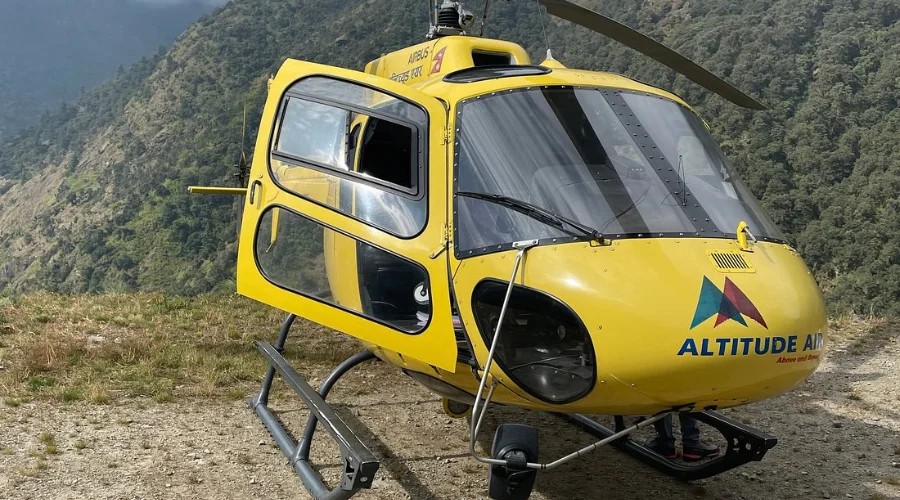
You will also get regular flights from Kathmandu to Lukla, but only one or two airlines operate during this season. However, due to the overcrowding during these seasons, you must pre-book for the flights from Kathmandu to Lukla.
Himalayan Masters will help you to book a flight from Kathmandu to Lukla. So, contact us via email or any means of social media to book a flight.
Lukla Flight Delay and Cancellation Chances
Another major consequence one might face for the flight is a delay due to bad weather in Lukla or even Kathmandu.
The flight to Lukla sometimes experiences cancellations and delays due to weather conditions such as low visibility, storms, snow, and rain. But do not worry! It won’t cost any additional money to fly again to Lukla as per the flight instructions and details.
Lukla Return Flight from Gorakshep
As per our itinerary, you will return to Lukla by helicopter from Gorakshep. According to government rules and regulations, the helicopter from Gorakshep can accommodate only two people.
If your group consists of more than two people, the helicopter will shuttle two individuals at a time. The helicopter will land the first two people at Pheriche, then fly back to Gorakshep to bring the next two people.
When the shuttle is full of four people, the helicopter will fly from Pheriche to Lukla. There is also an alternative way: the group can walk back up to Lobuche and fly in groups of 4 from Lobuche to Lukla.
Everest Helicopter Return Custom Itinerary
Himalayan Masters believe in trekkers’ satisfaction and matching their expectations. So, if the trekker has any itinerary changes that are per their preferences, we are always there for you.
Itinerary changes can include adding extra days, reducing the durations, upgrading the services and accommodations, and much more, as per your expectations. For such tailoring, please contact us beforehand for an effortless and smooth process.

Trek Benefits from Himalayan Masters
- 24/7 communication support is available on WhatsApp, Viber, Facebook, and Instagram.
- Free airport pickup and drop-off services.
- Offline as well as online trip briefing as per your preference.
- Easy and hassle-free itinerary customization.
- Straightforward and easy trip booking.
- Waterproof free duffle bag for trekkers.
- Himalayan Masters brand Cap, T-shirt, and Water bottle as a souvenir.
- Water purification tablets ensure you get safe drinking water.
- If you have no trekking gear, we provide it, too, like trekking poles and crampons.
- We also provide –25 degrees Down jacket and Sleeping bags.
- For easy baggage and luggage storage, we provide free storage at the Himalayan Masters office located at Thamel, Kathmandu.
- Best licensed and experienced trekking guides for the trek.
- Top-notch accommodation, transportation and food during the trek.
- Last minute booking with us.
- Trekking certificates after completing the trek.
9-day Everest Base Camp Trek With Helicopter Return Itinerary Outline
| Day | Itinerary | Sleep Altitude | Duration |
| 01 | Flight From Kathmandu to Lukla & trek to Phakding | 2610 m/8563 ft. | 3.5-4.5 hrs |
| 02 | Trek From Phakding to Namche Bazaar | 3440 m/11286 ft. | 6-7 hrs |
| 03 | Acclimatization Day at Namche Bazaar – Hike to Hotel Everest View | 3440 m/11286 ft. | 3 hrs (Round) |
| 04 | Trek from Namche to Tengboche | 3860 m/12664 ft. | 5-6 hrs |
| 05 | Trek from Tengboche to Dingboche | 4410 m/14468 ft. | 6-7 hrs |
| 06 | Acclimatization Day at Dingboche – Hike Nagarjuna Hill Top | 4410 m/14468 ft. | 6-7 hrs (Round) |
| 07 | Trek from Dingboche to Lobuche Via Thokla Pass | 4910 m/16109 ft. | 6-7 hrs |
| 08 | Trek from Lobuche to Gorakshep & Hike to Everest Base Camp | 5140 m/16863.5 ft. | 9-10 hrs (Round) |
| 09 | Early morning Hike from Gorakshep to Kala Patthar for sunrise & Helicopter Flight from Gorakshep to Lukla and regular fixed-wing flight to Ramechap or Kathmandu | 1400 m/4593 ft. | 4-5 hrs |
ITINERARY
Day 01: Flight From Kathmandu to Lukla (2840 m) & trek to Phakding (2618 m)
Route: Kathmandu → Lukla → Chheplung → Thado Koshigaon → Ghat → Phakding
- Beginning Point: Kathmandu (1400 m/4593 ft)
- Ending Point: Phakding (2618 m/8589 ft)
- Lukla to Phakding Distance: 7.8 km (5 miles)
- Total Ascent: 1218 meters (3996 ft) from Kathmandu to Phakding
- Lunch: Thado Koshigaon
- Overnight: Phakding
After an early morning breakfast, your Everest Base Camp Trek with a Helicopter return trip starts with a 25-minute thrilling flight from Kathmandu to Lukla.
The Lukla airport has a high chance of flight delays and cancellations, as the weather in the Lukla region is not clear daily.
Your guide will accompany you from Kathmandu, but you will find the porter after landing in Lukla.
Usually, the flight to Lukla can be taken from the airport in Kathmandu. However, the flight from Kathmandu to Lukla might always be unavailable, especially during peak trekking seasons. In that case, we need to ride early in the morning (about 4 a.m.) to Manthali/Ramechhap Airport and catch a flight from there.
Note: To avoid the tiring drive to Ramechhap airport, if the flight is not available from Kathmandu, you can book a private helicopter tour to Lukla for $500 per person. The helicopter can be shared among 5 people.
After landing at Lukla, called Tenzing-Hillary Airport, you must walk for nearly 4 hours downhill. You will pass through many beautiful villages, such as Koshigaon and Ghat, which can be seen during the Everest Base Camp Trek.
The trekking trail goes through the Sagarmatha National Park, a conservation area enlisted in UNESCO Heritage site in Nepal. The trek offers a pristine view of mountains and the Dudh Koshi River as you walk by.
If your flight arrives on time, you can even trek to Monjo on the same day.
Before reaching Phakding, after walking for around 2 hours, we will stop at Thado Koshigaon for lunch. Then, continue the trek to Phakding to stay overnight.
About Lukla
Lukla is a busy town, serving as an entry point for several treks in the Everest region. The town is located at 2840 meters (9318 ft). It is also popular for one of the shortest flight runways in the world, 527 meters.
Here, while we arrange the local porters, you can visit around town or enjoy a small meal at one of the best lodges. There are about 25 hotels in Lukla, where you can find modern services and visit historic monasteries, police offices, army barracks, etc. nearby.
About Thado Koshigaon
Thado Koshigaon falls en route to Everest Base Camp, where we will stop for a couple of hours to have lunch. There are about 5-6 decent teahouses here that provide basic food and accommodation services.
About Phakding Village
Phakding is a popular village in the Everest region. It is situated at 2618 meters (8589 ft) altitude at the bank of Dudh Koshi River.
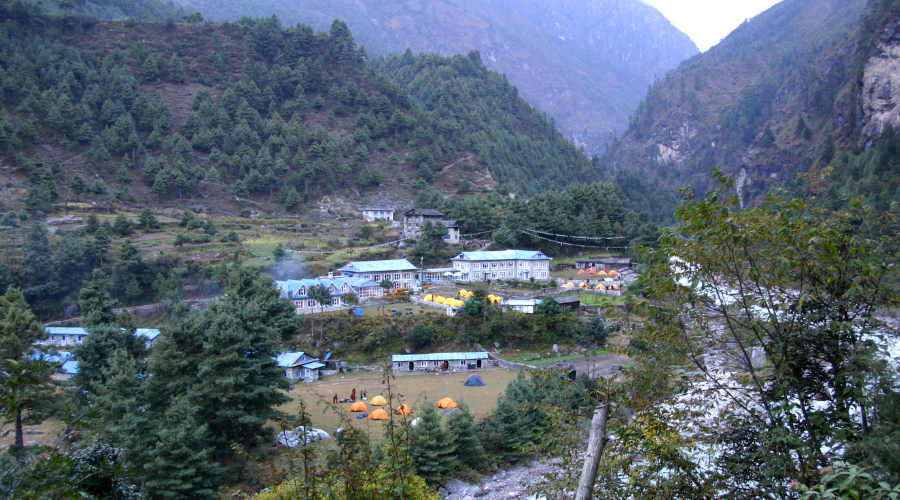
You can find several teahouses in Phakding. You will stay at Pine Forest teahouse in Phakding, with an attached toilet bathroom. The hotels are essential but are very comfortable. You will also have a hot shower if you want. There are around 25 lodges, accommodating about 3000 tourists each night in Phakding.
Teahouses en route Phakding
Lukla: About 25 hotels
Thado Koshigaon: 4-5 teahouses
Phakding: 20-25 teahouses
About the Teahouse:
- Luxurious hotels in Lukla with attached bathrooms, hot showers, electric heating bathrooms, etc.
- Basic teahouses in Thado Koshigaon, normal lunch-based teahouses.
- Teahouses are essential to luxurious facilities in Phakding.
- No cost for Wi-Fi, hot shower, charging, etc.
Meal : Breakfast, Lunch & Dinner
Accommodation : Tea House
Walking / Driving : 30-35 min Flight & 3-4 Hours Walking
Day 02: Trek From Phakding to Namche Bazaar (3440 m)
Trek Route: Phakding → Monjo → Jorsalle v Hillary Bridge (Larja Dobhan) → Namche Bazaar
- Beginning Point: Phakding(2618 m/8589 ft)
- Ending Point: Namche Bazaar (3440 m/11,286 ft)
- Phakding to Namche Bazaar Distance: 10.4 km (6.5 miles)
- Total Ascent: 822 meters (2697 ft) from Phakding
- Lunch: Jorsalle
- Overnight: Namche Bazaar
On the second day of the Everest Base Camp Trek, return by helicopter. You will start your trek to Namche Bazaar. After trekking for about 5 km, you will reach Monjo (2835 m/9301 ft). Namche is just 5.5 km away from Monjo.
Here, you need to show your Sagarmatha National Park permit.
You will have your lunch at Jorsalle. There are a variety of lunch options; there is no specific lunch or food you should eat. Then, after having lunch at Jorsalle, you must continue the trek for 2 hours on a gradual ascent to reach Namche via Hillary Bridge.
The total trek time for today is 6-7 hours. Although this part of the trek is quite challenging, the first sight of Everest after crossing Hillary Bridge is worth the challenge.
About Jorsalle Village
Jorsalle is a small village with only 5-6 teahouses with basic facilities.
After having lunch at Jorsalle, you will only find teahouses once you reach Namche. However, you can find local vendors selling goods in “Nanglo”.
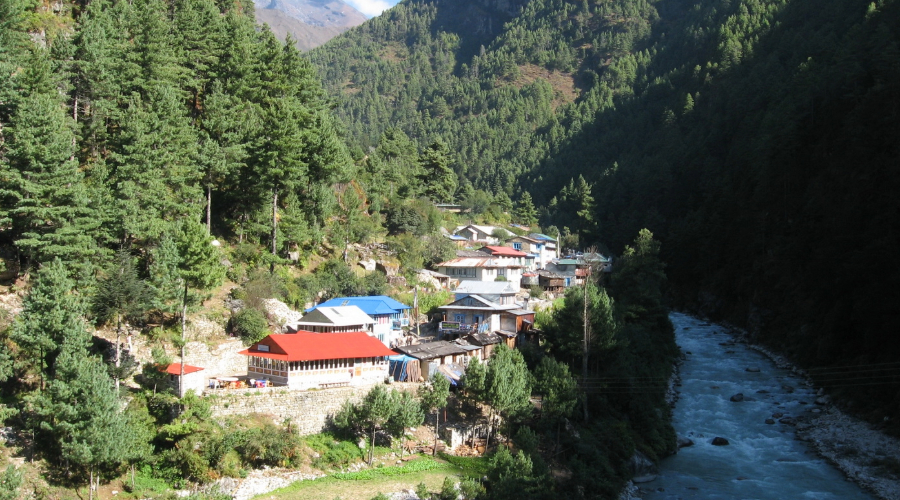
About Namche Bazaar
“The Gateway to Everest,” Namche is a busy trading port in the Everest region. The Namche Bazaar is famous for buying and selling trekking and mountaineering gear and local traditional items. You can also enjoy the Saturday market in Namche, where vendors from different places come to sell various items.
Additionally, the town has a bank, ATM, money exchange services, pool houses, art galleries, pharmacies, a school, etc.
Himalayan Masters will provide you with a good teahouse for your accommodation in Namche. We will provide an attached bathroom, hot shower, and warm electric blanket. Namche has good accommodation facilities and many teahouses along the way.
Teahouses en route Namche:
Jorsalle: 5-6 teahouses
Namche: 40-50 hotels
About the Teahouse:
- Teahouses in Jorsalle have basic luncheon services.
- In Namche, teahouses/hotels have attached bathrooms, hot showers, warm electric blankets, etc.
- No need to pay extra for electricity, charging, and internet.
Note: Internet and cellular service above Namche can be accessed via Everest Link. Everest Link is a cellular service limited to the Khumbu region. You need to recharge or take the data package once it is over.
Meal : Breakfast, Lunch & Dinner
Accommodation : Tea House
Walking / Driving : 6 to 7 Hours (Walking)
Day 03: Acclimatization Day at Namche Bazaar (3440 m)
Hike Route: Namche Bazaar → Hotel Everest View → Namche Bazaar
- Distance: 7-8 km (4-5 miles)
- Hotel Everest View Elevation: 3900 meters (12,795 ft) at Hotel Everest View
- Total Ascent: 460 meters (1509 ft) from Namche
- Lunch: Snacks at Hotel Everest View

Day third is the first day of your acclimatization during the Everest base camp trek, including a helicopter return.
On this day, you’ll let it easy and let your body rest and acclimatize to the higher altitudes. You can also explore the area by visiting viewpoints like Thamo, Khumjung, Kunde, and the Sherpa people.
You can even hike to the Hotel Everest View for stunning views of Mt. Everest, Ama Dablam, Lhotse, Nuptse, and other mountains. The hike will take about 2 hours uphill and 1 hour downhill. You need to carry a packed lunch for the hike or have one after you return to Namche.
After a day of exploring, you’ll return to Namche for the evening, passing by a picture gallery, museum, and Sherpa settlements.
Meal : Breakfast, Lunch & Dinner
Accommodation : Tea House
Walking / Driving : Around 3 Hours (If the Trekkers want to)
Day 04: Trek from Namche to Tengboche (3860 m)
Route: Namche Bazaar → Khyangjuma → Phunke Tenga → Tengboche
- Beginning Point: Namche Bazaar (3440 m/11,286 ft)
- Ending Point: Tengboche (3860 m/12,664 ft)
- Namche Bazaar to Tengboche Distance: 6 km (3.7 miles)
- Total Ascent: 420 meters (1378 ft) from Namche Bazaar
- Lunch: Phunke Tenga
- Overnight: Tengboche

After having tummy full breakfast in Namche, you will start your trek early at around 8 to 9 a.m. Today, your destination is going to be Tengboche, and you will spend the night there.
You will pass through Khyangjuma, a village, after walking from Namche for 3 – 4 hours. The route on this day is not very challenging. The paths are straight. Then, we will descend gradually to Phunke Tenga for our lunch.
After lunch, we will trek for 2 hours to Tengboche. The path has a 2-hour ascent. There are around 4-5 teahouses in the Tengboche area. We will stay overnight at Tengboche.
About Phunke Tenga
Phunke Tenga, situated at an elevation of 3250 meters (10,663 ft), is our lunch station for the fifth day of our trek. You can enjoy lunch with a view of Dudh Koshi, which originates from Everest and Gokyo Lakes.
About Tengboche
Tengboche is a small picturesque village en route to the EBC Trek. It is situated at an altitude of 3860 meters (12,664 ft). Tengboche Monastery is a must-visit site in Tengboche. The monastery is located in the area, so trekkers can enjoy the evening ceremony performed by the locals at the monastery.
Tengboche monastery is located in the area, so trekkers can enjoy the evening ceremony performed by the locals there. We can also see scenic views of Ama Dablam, Everest, Lhotse, Tabuche/Taboche, and many more mountains.
Teahouses en route Tengboche
Phunke Tenga: 5-6 teahouses
Tengboche: 4-5 teahouses
About the Teahouses
- Basic facilities with basic food and accommodation.
- Good and healthy food in Tengboche.
- Food costs around NRS 500-700 per meal on average.
- Extra charge of NRS 300-500 for extra services.
Meal : Breakfast, Lunch & Dinner
Accommodation : Tea House
Walking / Driving : 5 to 6 Hours (Walking)
Day 05: Trek to Dingboche (4410 m)
Trek Route: Tengboche → Deboche → Pangboche → Somare → Dingboche
- Beginning Point: Tengboche (3860 m/12,664 ft)
- Ending Point: Dingboche (4410 m/14,468.5 ft)
- Tengboche to Dingboche Distance: 8 km (5 miles)
- Total Ascent: 550 meters (1805.5 ft) from Tengboche
- Lunch: Somare
- Overnight: Dingboche
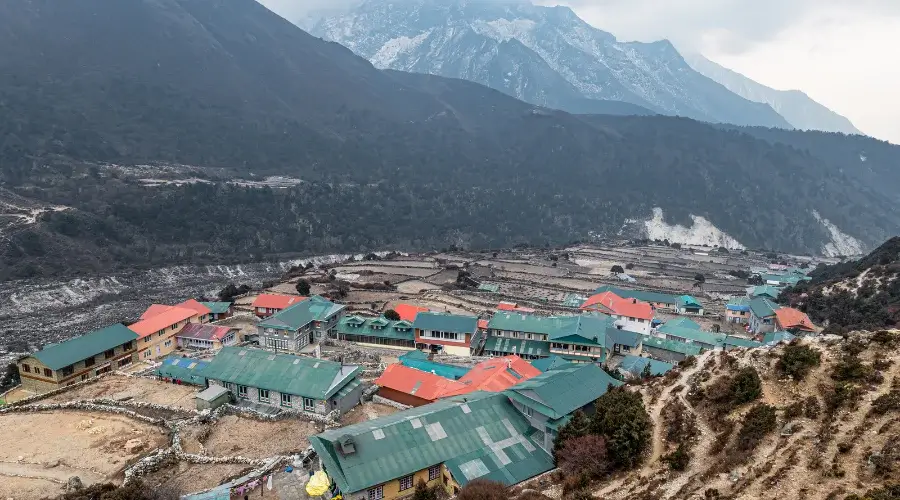
On the fifth day of the trek, you will have breakfast and begin your Everest base camp trek with a Heli flyout.
After walking for 30 minutes, the path takes you to Diboche, where you will gradually descend. Then, you will trek to Pangboche (3930 m) and Somare, which will take around 2 hours to reach.
The trekking route goes along the Imja River. On this day, you will have lunch in Somare.
After a delicious lunch, you need to cover about 4-5 km, which takes 2-3 hours. You will stay overnight in Dingboche.
About Pangboche
Pangboche (3930 m/12893.7 ft) is a Tibetan Village in the Everest region.
The major highlight of Pangboche is a 350-year-old monastery built by Lama Sangwa Dorjee. Furthermore, Pangboche is famous for its excellent views of Ama Dablam and the statue of Yeti’s head.
About Somare
Somare, at 4010 meters (13,156 ft), is a bucolic village en route EBC trek with Helicopter return. The village offers an excellent panoramic view of the Himalayas and a lush jungle view.
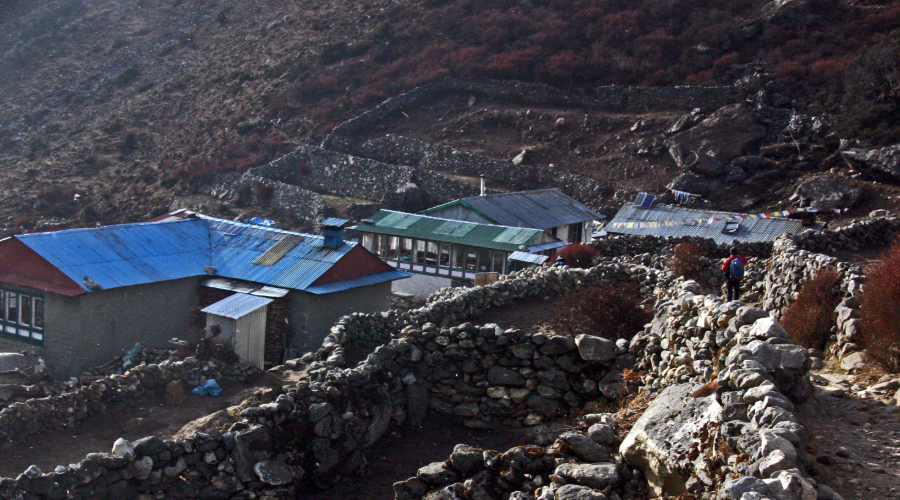
Teahouses in Somare:
- 4-5 basic teahouses
- You must pay an extra fee for a hot shower, charging, etc.
- Internet service can be accessed through Everest Link.
- Decent food and accommodation.
About Dingboche
Dingboche is situated at an altitude of 4410 meters (14,468.5 ft). Dingboche has about 20-25 teahouses, ranging from basic to quality teahouses. You can spend some time here playing pool if you feel like it or visit the bakery and savour bakery items.
Teahouses in Dingboche:
- From basic to good-quality Teahouses.
- Neat and clean accommodation.
- Additional charge for hot showers, charging batteries, bottled water, etc.
Meal : Breakfast/ Lunch/ Dinner
Accommodation : Teahouse
Walking / Driving : 5 hours
Day 06: Acclimatization Day at Dingboche (4410 m)
Hike Route: Dingboche → Nagarjuna Hill Top → Dingboche
- Distance: About 5 km (3.1 miles)
- Nagarjuna Hill Top Elevation: Nearly 5000 meters (16,404 ft)
- Total Ascent: Nearly 600 meters (1968.5 ft) from Dingboche
- Lunch: Packed lunch
This day is also an acclimatization day. It will help you to rest yourself mentally and physically. Acclimatization is necessary for the Everest Base camp trek to return back by helicopter. You can stay at the hotel and rest or use this day to explore Dingboche and villages nearby, like Chhukung and Imja. You can also go for a short hike to Chhukung Ri.
Our guide will lead you to the Nagarjuna Hill Top Viewpoint (at the base of Nangkar Tshang Peak) or Chhukung Ri if you can take a short hike. You can choose one of these short hikes, as you cannot do them in a single day.
The hike to the viewpoint will take approximately 3 hours uphill and 2 hours downhill. From this viewpoint, you can see awe-inspiring views of different mountains, such as Makalu, Lhotse, Island Peak, etc.
Note: Remember to carry a packed lunch for the hike.
Meal : Breakfast, Lunch & Dinner
Accommodation : Tea House
Walking / Driving : Around 5 Hours Walking (If the Trekkers want to)
Day 07: Trek from Dingboche to Lobuche (4940 m)
Trek Route: Dingboche → Dusa Kharka → Thukla/Dughla → Thokla Pass → Lobuche
- Beginning Point: Dingboche (4410 m/14,468.5 ft)
- Ending Point: Lobuche (4940 m/16,207 ft)
- Dingboche to Lobuche Distance: 6-7 km (around 4 miles)
- Total Ascent: 500 meters (1640 ft) from Dingboche
- Lunch: Thukla
- Overnight: Lobuche
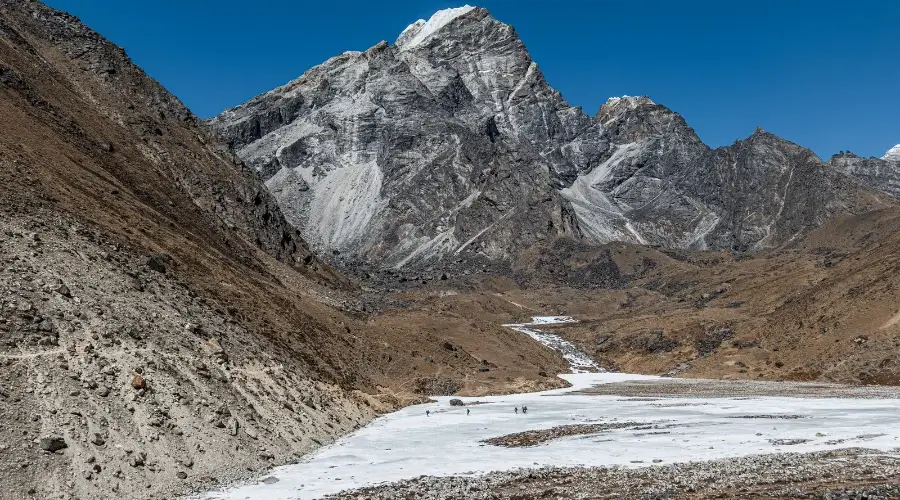
The walk from Dingboche gets more exciting as you climb higher. After climbing a steep route, you’ll pass by Thukla, a village. You will walk through Thukla Pass for around one hour.
From Thukla, the path gets tougher as you ascend to Chupki Lhara. Here, you’ll see stones covered in prayer flags honouring mountaineers who died on Everest.
As you continue towards Lobuche, the route becomes easier. The trek from Dingboche to Lobuche is one of the most beautiful days to trek. It offers stunning views of Everest base camp, Kala Patthar, the Khumbu glacier, and beautiful peaks like Khumbutse and Pumori.
You will be having lunch at Thukla and dinner at Lobuche on this day.
About Thukla
A picturesque village, Thukla is situated at an elevation of 4620 meters (15,157.48 ft). It is our lunch station for the day, where you will find just 2-3 basic teahouses. Here, you will rest for a couple of hours as the trek takes significant ascent hereafter. Additionally, there are no resting points until you reach Lobuche.
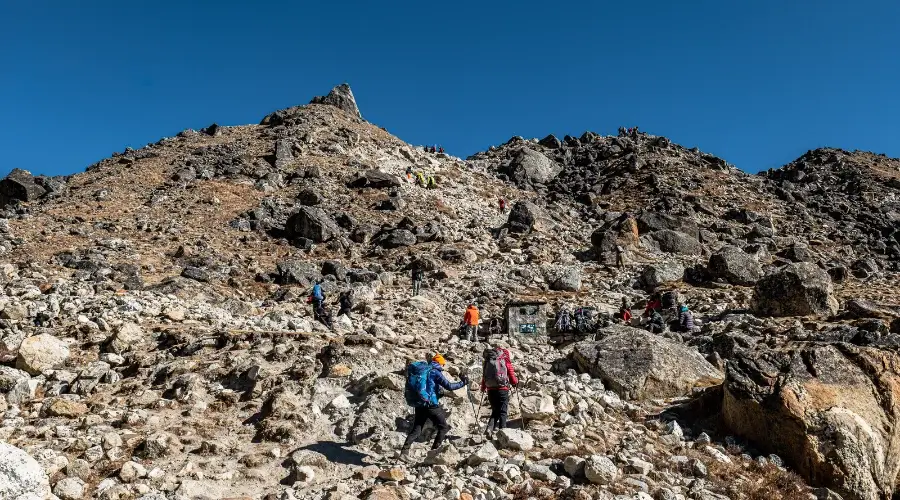
About Lobuche
Lobuche is a small, charming village located in the Everest region of Nepal at an elevation of 4910 meters (16109 ft). It is popular for its awesome views of Lobuche Peak: Lobuche East (6119 m) and Lobuche West (6145 m), Nuptse (7861 m), and Kangchung Peak (6063 m).
Teahouses in Lobuche:
- 5-6 basic teahouses.
- Local and healthy food from locally grown vegetables.
- Neat and clean accommodation.
- Additional fee for bottled water, charging battery, and other amenities.
Meal : Breakfast, Lunch & Dinner
Accommodation : Tea House
Walking / Driving : 6 to 7 Hours (Walking)
Day 08: Trek from Lobuche to Gorakshep (5164 m) & Hike to Everest Base Camp (5364 m)
Route: Lobuche → Gorakshep → Everest Base Camp → Gorakshep
- Beginning Point: Lobuche (4940 m/16,207 ft)
- Ending Point: Everest Base Camp (EBC) (5364 m/17,598 ft)
- Lobuche to EBC and back to Gorakshep Distance: About 12 km
- Maximum Elevation: 5364 meters (17,598 ft) at EBC
- Total Ascent: 454 meters (1489.5 ft) from Lobuche to EBC
- Descent: 224 meters (735 ft) from EBC to Gorakshep
- Lunch: Gorakshep
- Overnight: Gorakshep
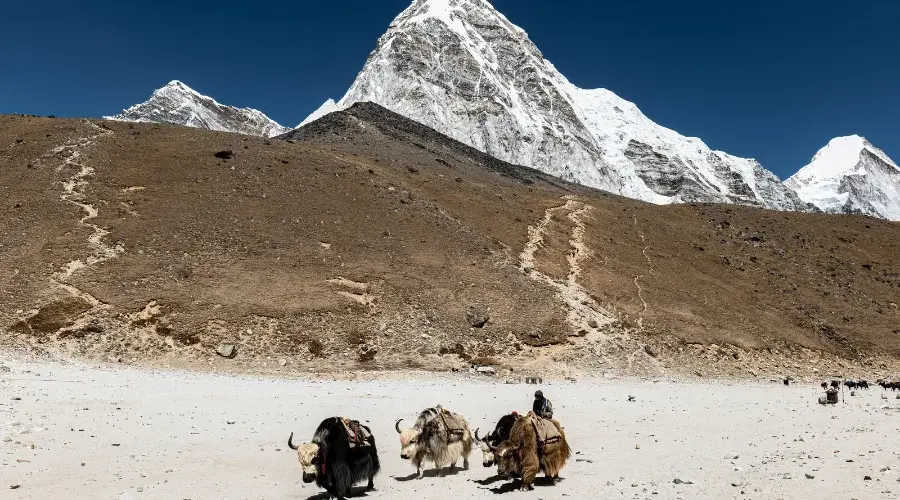
On this day, you will gradually trek for around 5 hours to reach Gorakshep. You will have your lunch at Gorakshep. Then, you will trek to the most awaited place in the Everest Base Camp trek Heli return.
After spending some time in Gorakshep, we will trek for 2-3 hours to reach Everest Base Camp. After capturing some photos and videos and enjoying the views of the Everest region, you will trek back to Gorakshep. There are no accommodation facilities at Everest Base Camp.
The route to EBC from Gorakshep has several ups and downs. The EBC presents itself with an alluring view of the snow-capped Mahalangur Himalayan ranges.
About Gorakshep
Gorakshep is yet another famous village in the Everest region, at an altitude of 5140 meters (16,8643.5 ft) in Nepal. The path leading to Gorakshep is steep and rocky, with rocks and glaciers covering the slopes of the mountain.
Teahouses in Gorakshep
- 5-6 medium to better standard teahouses.
- Hot showers, battery charging, etc., come with an additional charge.
- Healthy and good quality food.
- Clean and warm accommodation.
- Internet and cellular service through Everest Link.
Meal : Breakfast, Lunch & Dinner
Accommodation : Tea House
Walking / Driving : 9 to 10 Hours (Walking)
Day 09: Early morning Hike from Gorakshep to Kala Patthar for sunrise & Helicopter Flight from Gorakshep to Kathmandu
Hike Route: Gorakshep → Kala Patthar → Gorakshep → Lukla → Kathmandu
Flight Route: Gorakshep → Lukla → Kathmandu
- Beginning Point: Gorakshep (5164 m/16,942 ft)
- Ending Point: Kathmandu (1400 m/4593 ft)
- Trek Ascent: 410 meters (1345 ft) from Gorakshep to Kala Patthar
- Trek Descent: 3740 meters (12,270 ft) from Kala Patthar to Kathmandu
- Lunch: Gorakshep
- Overnight: Kathmandu
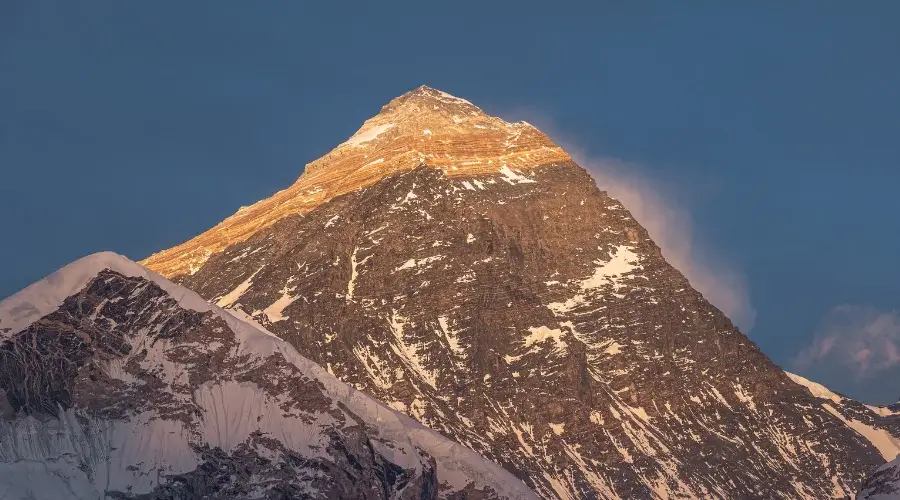
On the last day of your Everest Base Camp helicopter trek, you will wake up early to reach Kala Patthar and see the wonderful sunrise.
After trekking for around 2.5 hours, you will reach Kala Patthar (the highest point on the EBC trek). Since the route descends on the way back to Gorakshep, the return trip will take only about 1.5 hours.
Then, you will have your last breakfast in the mountains and prepare to return to Kathmandu.
You will end the Everest Base Camp Trek with a helicopter return at Gorakshep and a helicopter ride to Lukla. You will then have a delicious lunch in Lukla and finally fly back to Kathmandu by helicopter.
After arriving in Kathmandu, we will arrange comfortable and cozy accommodations.
Kala Patthar in Brief:
Kala Patthar, also known as “Black Rock”, is situated at an altitude of 5550 meters (18,209 ft). The Everest View Range Viewpoint, Kala Patthar, is the highest point of our trekking journey.
If you want to travel directly to Kathmandu rather than Lukla, Himalayan Masters will manage it.
On the package, Himalayan Masters will take you to Lukla by helicopter, then fly to Kathmandu.
Meal : Breakfast, Lunch & Dinner
Accommodation : 3-Star Hotel
Walking / Driving : 2.5-3 Hours (Walking) & 1 to 1.5 Hours (Flight)
Fixed Departure
| Trip Date | Trip Status | |
|---|---|---|
| 30-09-2025 | OPEN | book now |
| 03-10-2025 | OPEN | book now |
| 10-10-2025 | OPEN | book now |
| 20-10-2025 | OPEN | book now |
| 23-10-2025 | OPEN | book now |
| 30-10-2025 | OPEN | book now |
| 02-11-2025 | OPEN | book now |
| 06-11-2025 | OPEN | book now |
| 12-11-2025 | OPEN | book now |
| 19-11-2025 | OPEN | book now |
| 25-11-2025 | OPEN | book now |
| 30-11-2025 | OPEN | book now |
| 02-12-2025 | OPEN | book now |
| 10-12-2025 | OPEN | book now |
| 15-12-2025 | OPEN | book now |
| 20-12-2025 | OPEN | book now |
| 24-12-2025 | OPEN | book now |
| 26-12-2025 | OPEN | book now |
| 01-01-2026 | OPEN | book now |
| 01-03-2026 | OPEN | book now |
| 06-03-2026 | OPEN | book now |
| 09-03-2026 | OPEN | book now |
| 15-03-2026 | OPEN | book now |
| 20-03-2026 | OPEN | book now |
| 24-03-2026 | OPEN | book now |
| 29-03-2026 | OPEN | book now |
| 01-04-2026 | OPEN | book now |
| 06-04-2026 | OPEN | book now |
| 09-04-2026 | OPEN | book now |
| 14-04-2026 | OPEN | book now |
| 18-04-2026 | OPEN | book now |
| 21-04-2026 | OPEN | book now |
| 26-04-2026 | OPEN | book now |
| 29-04-2026 | OPEN | book now |
| 01-05-2026 | OPEN | book now |
| 03-05-2026 | OPEN | book now |
| 09-05-2026 | OPEN | book now |
| 15-05-2026 | OPEN | book now |
| 21-05-2026 | OPEN | book now |
| 24-05-2026 | OPEN | book now |
| 28-05-2026 | OPEN | book now |
| 01-06-2026 | OPEN | book now |
include / exclude
Trip Cost Includes
- We offer both international and domestic airport pick-up and drop-off services by private car.
- Two nights of accommodation in Kathmandu (3-star standard hotel)
- Kathmandu to Lukla to Kathmandu airfare
- A professional trekking guide for the trek
- Trekking porter for nine days of trekking (One porter carries up to 30 kg)
- 1 set Breakfast, 1 set lunch and 1 set dinner in the mountains as per the itinerary
- Three cups of hot drinks in the mountains
- Accommodation in a private room throughout the trek.
- Two nights of luxury lodge accommodation in Namche with electric blankets
- Sagarmatha National Park permits
- Khumbu Municipality area permits
- Guide and Porter Insurance
- All government taxes and company service charges
Complimentary Services from Himalayan Masters
- Use a 25-degree sleeping bag during the trip if needed.
- Himalayan Masters brand Down jacket during the trek
- Use a pulse oximeter to check your spo2 and bpm at high elevations.
- Water bottles and purification tablets by Himalayan Masters
- First aid kit box.
- Seasonal fruits for dessert.
- The Himalayan Masters brand duffle bag for the trip
- Himalayan Masters Brand Trekking T-Shirt and Cap
- Oxygen bottle for emergencies during climbing and trekking.
Trip Cost Excludes
- Nepal visa
- International flights tickets
- lunch and dinner in the city
- After Namche Wifi, battery charging and the hot shower
- Tips for guide and the porter
useful info
Trip Grade: Fitness Level, Medical, and Health
When we talk about the fitness level required for an Everest base camp trek with Heli return, we mean how fit you must be. Some treks require you to be fit and ready for a challenge, while others are easier and more suitable for less fit people.
On the medical side, it’s essential to consider things like altitude sickness and how the trek might affect your health. Altitude sickness can occur when you go to high places too quickly, and your body doesn’t have enough time to adjust. It can make you feel sick and weak, so it’s something to be aware of, especially on treks at high altitudes.
Health is also important because you want to ensure your health before starting a trek. If you have health concerns or are unsure if a trek suits you, check with a doctor. It’s also essential to stay healthy during the trek, so bringing medications and caring for yourself along the way is a good idea.
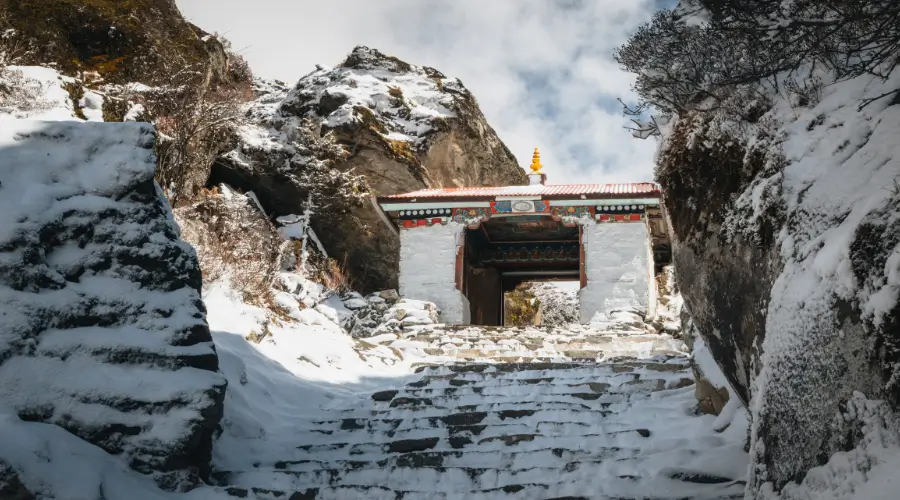
Everest Base Camp Trek with Heli Return Weather
Weather conditions significantly impact the success and safety of the Everest Base Camp trek with heli return.
Spring (March to May) and Autumn (September to November) are the optimal times for the journey, boasting stable weather with clear skies and warm temperatures.
Spring offers pleasant trekking conditions with temperatures ranging from 16°C to 23°C, while autumn provides crystal-clear views after the monsoon season, with temperatures ranging from 15°C to 24°C.
Summer (June to August) brings heavy rainfall, muddy trails, and temperatures between 9°C to 12°C, making trekking challenging and helicopter operations risky.
Winter (December to February) presents extreme cold, with temperatures below freezing and the possibility of heavy snowfall, adding to the trek’s difficulty and risk. Therefore, planning your Everest Base Camp trek during Spring or Autumn is advisable for optimal weather conditions and safety.
Difficulty of EBC Trek with Helicopter Return
The high altitudes make the Everest Base Camp helicopter trek difficult. The route is easy to follow, with clear paths and trails used by yaks. However, as you climb higher, the altitude makes it more challenging. You should be ready to walk for 6 to 7 hours daily, carrying your backpack with essential items like water, extra clothes, and snacks.
The trek reaches up to 5,550 meters at Kala Patthar. You’ll also need to sleep at an elevation of 5,000 m or higher for one night at Gorakshep. Previous trekking experience is optional, but you should be reasonably fit, enjoy walking, and adapt to high altitudes.
Trekking experience for Everest Base Camp trek with Helicopter return
Climbing to Everest Base Camp with a helicopter return trip is an incredible adventure. As you trek through the stunning Himalayan landscape, you’ll encounter challenges like steep paths and high altitudes, where the air is thin.

But the journey is worth it for the breathtaking views of snow-capped peaks and the sense of accomplishment when you reach Base Camp. The helicopter ride back gives you a different perspective of the mountains and lets you wonder at the region’s beauty one last time. It’s an experience you’ll never forget, filled with physical and emotional highs.
Emergency and Evacuation at Everest Helicopter Return Trek
Lukla also has a hospital and an airport for rescue operations in case of an emergency during your Everest Base Camp trek. Helicopter evacuation depends on the weather and visibility conditions around Everest.
In an emergency, the trekking team, guide, and local helpers will coordinate to move the person to a safe location and try to arrange for helicopter evacuation. However, bad weather can sometimes delay helicopter assistance, so it’s essential to be prepared and able to manage situations independently in the mountains.
If you need a helicopter evacuation, you can arrange it through your insurance. Contact your insurance company directly and provide them with your policy number, name, address, and the date you purchased the policy. This information is necessary to open a case and explain the emergency.
Altitude Sickness at Everest Base Camp Helicopter Flyout
On this Everest base camp with helicopter return, you’ll climb higher and higher. It’s one of the highest treks you can do. The highest point, Kala Patthar, is about 5,550 meters. You’ll start your journey from Lukla, which is already high up at 2,840 meters (9318 ft).
When you go up that high, you risk altitude sickness. This is not good news for trekkers like us. It can make you feel sick and even cause serious problems. If someone gets sick, they might need to be evacuated immediately for medical help.
While this trek will be unique, we must watch for signs of altitude sickness. Safety first, right?

Special training for Everest Trek with Helicopter Return
The Everest Base Camp Trek is the best adventure for outdoor enthusiasts and nature lovers. It’s known to be challenging, so preparing yourself beforehand is essential. Your fitness level, age, lifestyle, and diet affect how well you’ll do on the trek. Before you start, it’s wise to check with your doctor to ensure you’re healthy enough for the journey.
If you’re good to go, consider talking to a trainer or a nutritionist for extra guidance, although it’s only sometimes necessary. Training for the Everest Base Camp Trek concerns building up your stamina and strength to handle the long days of hiking at high altitudes. It’s all about being prepared and taking care of yourself along the way.
Preparation for Everest Base Camp Trek with Helicopter Return
When it comes to the Everest Base Camp trek, preparation is everything. It’s like the old saying: failing to prepare is preparing to fail.
But here’s the thing: preparing for this trek is about finding the right balance. You can’t just focus on one side; it’s a 50-50 split between mental and physical preparation.
Physical Preparation: Start Early, Hit the Gym
Physical preparation is key, and it starts way before you land in Nepal. Don’t wait until you arrive here to start thinking about getting fit.
You need to hit the gym, focus on your cardio, and get your legs stronger. Hiking for hours in high altitudes is tough, so you want to make sure your body can handle the stress.
Whether it’s doing stair climbing, long walks, or working on leg strength, start building that stamina months before your trip. The more you prepare physically, the better you’ll feel when you’re out there trekking.
Mental Preparation: Push Through the Limits
Now, let’s talk about mental preparation – it’s just as important as the physical side if not more. Everyone who’s ever attempted Everest Base Camp has probably hit that moment when they want to turn around.
It’s hard, it‘s exhausting, and at some point, you’ll feel like saying, “I can’t do this anymore, I want to go back”.
But here’s the secret: that’s normal. The key is to prepare your mind for those moments. Understand that there will be times when you’ll feel like quitting.
When the altitude kicks in, your legs ache, and the cold weather makes everything feel ten times harder, don’t let that inner voice win.
Stay focused, stay determined, and remind yourself why you’re here. Prepare to push through when your mind says, “Nope!” and your body is screaming for a break.
Other Essential Prep Tips
Beyond the physical and mental sides, there are a few more things to check off your list. Make sure your gear is on point. You need warm, high-quality clothes, good trekking shoes, and all the accessories that’ll help you survive the cold.
Hydrate and eat right during the trek to keep your energy levels up. Also, learn a little about altitude sickness. It‘s important to understand the signs and how to deal with them because that knowledge will keep you from freaking out when it hits.
So, whether you’re physically training in the gym or mentally preparing for those tough moments, just remember it’s all part of the journey. The trek to Everest Base Camp is tough, but the reward is worth it – and with proper preparation, you’ll make it to the top.
Comparing EBC Helicopter Return vs. Standard Trek Return
Planning the method of getting back from the Everest Base Camp base area is critical when arranging your EBC adventure.
You have two return options after reaching EBC: the first is to retrace your original trail, while the second involves helicopter travel. The method of return to base camp depends on your personal time constraints, energy levels, and chosen preferences.
A helicopter return provides the option to avoid up to four days of walking from EBC. The helicopter return option provides an excellent solution to those needing speed through their journey and seeking a stress-free ending to their trek.
Physically, the return by helicopter provides better body comfort than other methods. Your legs feel exhausted, so your knees might struggle with the decline at this time during the trek. Users obtain a necessary break from physical activity by flying back with a helicopter.
The ending of the trek demands that you maintain your physical strength as a continuous trek ward journey strains your knees and muscles heavily. Scenic value is an enormous difference between helicopter returns and trekking back. An aerial sight of the Himalayas becomes special when you travel by helicopter.
You will have a unique perspective of glaciers, mountain peaks, and flowing rivers when you view them from helicopter heights. This viewpoint differs entirely from the experience of walking. The return trek presents nice views yet presents no novel sights because it follows the initial trail back.
How to Make the Most of the Helicopter Return
Several activities exist to enhance your helicopter ride experience while returning from the Everest Base Camp. The start of your flight journey should take place in the morning hours.
The skies at this time tend to be free of clouds as mountains become most visible. Early flight times provide better conditions by preventing contact with powerful winds and sudden weather changes that develop throughout the day.
The first-morning flight ensures you will see the entire majestic Himalayan range in its most beautiful state.
Permits for Everest Base Camp Helicopter Tour
When trekking in Nepal, especially if you’re planning an Everest Helicopter Tour, you must arrange a few essential permits.
Sagarmatha National Park Permit supports the park’s ecology and helps preserve its beauty for future adventurers by controlling the number of visitors.
You might also need a local area permit from the Khumbu Pasang Lhamu Rural Municipality for the specific regions you’ll be visiting. These permits help manage tourism in those areas responsibly and protect the environment and local communities.
Finally, helicopter tour operators need aviation permits to ensure their flights meet safety standards and regulations.
Best Time for Everest Base Camp Trek with Helicopter Return
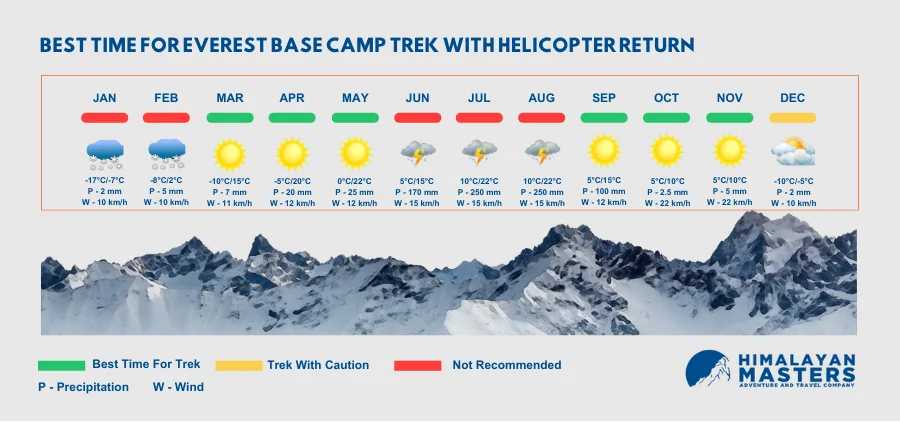
Many people ask if the Everest base camp trek is worth it. Knowing the best time for Everest Base Camp trek is important, especially since you’ll also be taking a Mt. Everest Base Camp helicopter tour.
Spring and autumn are the ideal times to go. Spring, from March to May, offers stable weather and beautiful views, although it can be crowded.
Autumn has clear skies and warm days from September to November, making it perfect for trekking.
Summer is rainy from June to August and not recommended for trekking, as the trails can be slippery and dangerous. Winter, from December to February, is cold but offers stunning snowy views, although it’s less popular due to the extreme temperatures.
The weather is stable in spring and autumn, making it safer for helicopter rescues if needed. Summer is rainy and not ideal for helicopter operations, while winter is cold and risky due to potential snowfall.
Packing List for Everest Base Camp Trek Return Back by Helicopter
When preparing for a return trip to Everest Base Camp by helicopter Gears list, it’s essential to pack wisely to ensure comfort, safety, and enjoyment throughout the journey.
Clothing:
- Fleece or down jacket
- Waterproof and windproof outer shell jacket
- Trekking pants and shorts
- Thermal underwear
- Warm hat and gloves
- Sun hat and sunglasses
Footwear:
- Sturdy hiking boots with ankle support
- Comfortable trekking socks
Everest Base Camp Gear list:
- Backpack with rain cover
- Sleeping bag for the trek (complimentary by Himalayan Masters)
- Headlamp or flashlight with extra batteries
- Water purification tablets (complimentary by Himalayan Masters)
- Snacks and energy bars
- Personal first-aid kit
- Durable camera or smartphone for capturing memories
- Portable charger or power bank
- Trekking map and guidebook
Personal Hygiene and Toiletries:
- Biodegradable soap
- Toothbrush and toothpaste
- Toilet paper and hand sanitiser
- Wet wipes or baby wipes
- Sunscreen (SPF 30+)
Miscellaneous:
- Passport and necessary permits
- Cash (Nepali rupees) for expenses along the trail
- Travel insurance, including emergency evacuation coverage
- Waterproof dry bags or plastic bags for keeping items dry
- Lightweight towel
Helicopter-Specific Items:
- Carry-on essentials for the helicopter ride (snacks, water, medications, camera)
- Motion sickness medication
Accommodation and Food during the Everest Helicopter Return
When you’re on the Everest Base Camp Helicopter Return trip, finding food and accommodation won’t be a problem. Along the way, there are many tea houses where you can eat and rest.
Locals run tea houses and offer a variety of food, such as noodles, dumplings, pizza, and the popular Traditional Nepali food, Dal Bhat.
At some stops, you can also find beverages like tea, coffee, energy drinks, and bakeries.
Tea houses offer twin-sharing rooms with basic amenities like beds and bedding. While the rooms are clean and well-priced, expect something other than luxury. Tea houses also provide additional services like hot showers, Wi-Fi, and charging facilities for extra charges.
Electricity and Battery recharge, Water during the Everest Hike
You’ll find electricity during the best Everest base camp trek with helicopter return in some teahouses, but it’s only sometimes reliable. They usually have solar to recharge your devices, like phones and cameras. However, bringing a portable charger just in case is a good idea.
You can refill your bottles at the teahouses or use purification tablets to make water from streams safe to drink. Before drinking it, consult with your guide if it is drinkable or not.
Staying hydrated is important, especially at higher altitudes, so always have enough water. Having a power bank will be suitable because, from Tengboche, you will have to rely on solar panels.
Roads on the Everest Trek and How to Avoid Them
On this trek with helicopter return, you’ll mostly be trekking on dirt paths and rocky terrain. These trails can be challenging, especially with the altitude and unpredictable weather. To avoid the most difficult parts, it is important to carefully plan your Everest Base Camp trek return by helicopter.
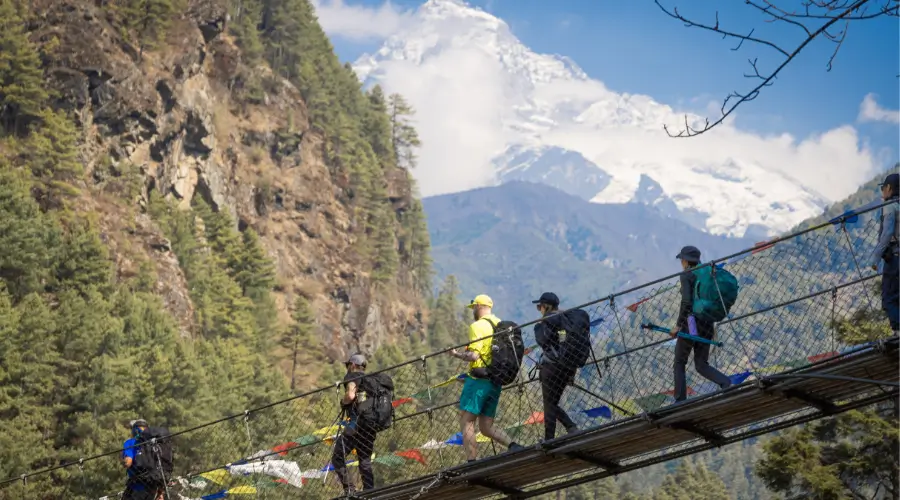
Why choose Himalayan Masters?
Booking/ airport pickup
Himalayan Masters provides airport pickup and drop-off services personalized to your flight schedule. Your transfers are arranged based on your flight information, ensuring a smooth journey. If your flight schedule changes, please let us know on time so we can adjust the transfers accordingly.
Upon arrival, look for our team, who will welcome you in the arrival area. You will then be transferred to your hotel for check-in. Similarly, for your departure, we will provide you with the airport in time for your flight.
Support Team
With Himalayan Masters, you’ll have a dedicated support team throughout your trekking adventure. From experienced guides to skilled porters, our team ensures your safety, comfort, and enjoyment every step of the way. We prioritise your needs and try to make your trekking experience in the Himalayas unforgettable.
Starting Point/ Ending Point of Everest Hike
Many people wonder where the Everest Base Camp trek starts. The start and end points are usually Lukla, a little town with an airport in the Khumbu region of Nepal. The trek starts with a scenic flight from Kathmandu to Lukla, where trekkers start their journey on foot.
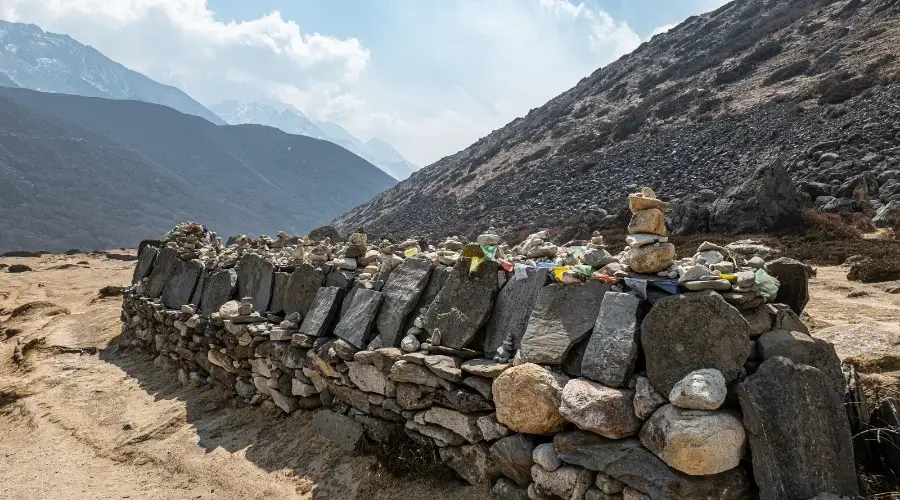
After trekking for days, depending on the itinerary, trekkers reach Everest Base Camp, the starting point for climbers attempting to summit Mount Everest. The Everest base camp trek return by helicopter concludes in Lukla, where trekkers catch a flight back to Kathmandu. Lukla serves as a gateway to the Everest region and shows stunning views of the Everest region throughout the journey.
A typical day on the Everest Base Camp Trek with Helicopter Return
During the Everest base camp trek, return by helicopter; you’ll wake up between 6:00 am and 7:00 am daily. We’ll decide the wake-up and breakfast times the night before during our briefing. Our schedule for the day depends on how long we’ll be walking.
After a filling breakfast, we’ll start our walk for the day. Before breakfast, pack your duffel bag, which the porter will carry while you eat. After walking for about 3-4 hours, we’ll stop for lunch. Usually, the afternoon walk is shorter, and we’ll reach our destination in time for tea.
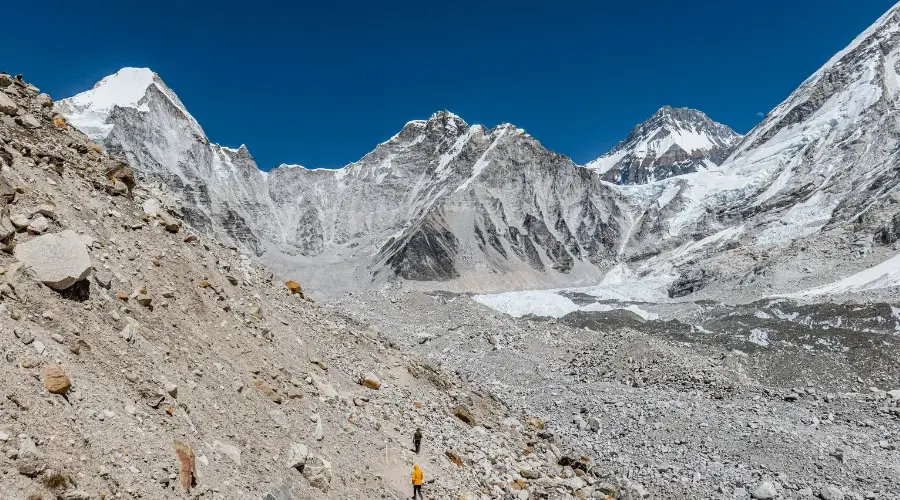
You’ll have the rest of the afternoon to explore, do laundry, or relax. Some days, we might arrive at our destination before lunch, giving us the whole afternoon free. After the dinner, your guide will provide a brief session about the next day’s trek.
Everest Base Camp Trek Return Back by Helicopter Cost
The Everest base camp trek cost with helicopter return costs $2405 per person. You’ll need to budget for permits, guides, and gear rental.
Guides help guide the terrain and ensure your safety. Gear rental includes boots, crampons, and ropes, which can add up. Budgeting for food and accommodation along the way is also a good idea.
Travel Insurance for Everest Base Camp Trek Return Back by Helicopter
Travel insurance is necessary for the Everest base camp trek with helicopter return. We require each trekker to provide a copy of their travel insurance certificate, covering medical expenses, emergency evacuation, and helicopter rescue at up to 6000 meters. This information should be submitted within a week of reserving the Everest base camp trek return by helicopter.
We will use your insurance policy to organize a quick and successful rescue in an emergency. Before purchasing, it’s essential to check with your insurance company to ensure they offer coverage for helicopter rescue and evacuation up to 6000 meters and do not solely rely on the information provided on their website.
Additional Expenses for Everest Heli Return Trek
In addition to trekking costs and insurance, there are other expenses you need to consider during the helicopter tour to Everest base camp. Additional expenses for additional drinks, snacks, souvenirs,
Your trip package covers almost everything required for the trek, including meals, accommodation, permits, and transportation to and from the trek’s starting point.
Planning and budgeting for these additional expenses is a good idea to avoid any surprises during your Everest base camp trek return by helicopter. The major additional expenses are tips for guides and porters and electricity and internet charges.
ATM in Everest Base Camp Trek
There are a few ATMs in Namche Bazaar, Dingboche, and Lukla. However, it would be best not to rely solely on these ATMs in the region. Sometimes, the internet connection might need to be fixed.
It’s best to bring enough cash with you for the entire Everest base camp trek and the return trip by helicopter, including extra for emergencies.
Most places along the Mount Everest base camp helicopter tour route only accept cash, so having enough is essential. Ensure to inform your bank of your travel plans to avoid issues with using your card abroad.
How do you book a helicopter to Return from EBC Trek?
To book an Everest Base Camp Trek with helicopter return, contact Himalayan Masters at [email protected] or WhatsApp at +977-9823636377.
Step 1: Choose Your Trek Package
Himalayan Masters offers various trek packages, including the Everest Base Camp Trek with Helicopter Return. This package allows you to trek to EBC and then fly back by helicopter from Gorakshep to Lukla, saving you the long trek back.
Step 2: Contact Himalayan Masters
Reach out to Himalayan Masters through our website or contact number. You can inquire about availability, costs, and any specific requirements you may have. We will respond as quickly as possible and can provide detailed information about the trek itinerary and helicopter arrangements.
Step 3: Confirm Your Booking
Once you have chosen your preferred dates and package, confirm your booking. You will need to pay a deposit to secure your spot. The total cost for the trek, including the helicopter ride, is $2405 per person.
Step 4: Prepare for the Trek
After booking, prepare for your trek by ensuring you have the necessary gear and physical fitness. The trek includes acclimatization days; you must be ready for high-altitude trekking. Himalayan Masters will guide you on what to pack.
Step 5: Enjoy the Trek and Helicopter Ride
During the trek, you will experience stunning landscapes and Sherpa culture. After reaching EBC and enjoying the views from Kala Patthar, you will take a helicopter back to Lukla. This flight offers breathtaking aerial views of the Himalayas, making your return journey memorable.
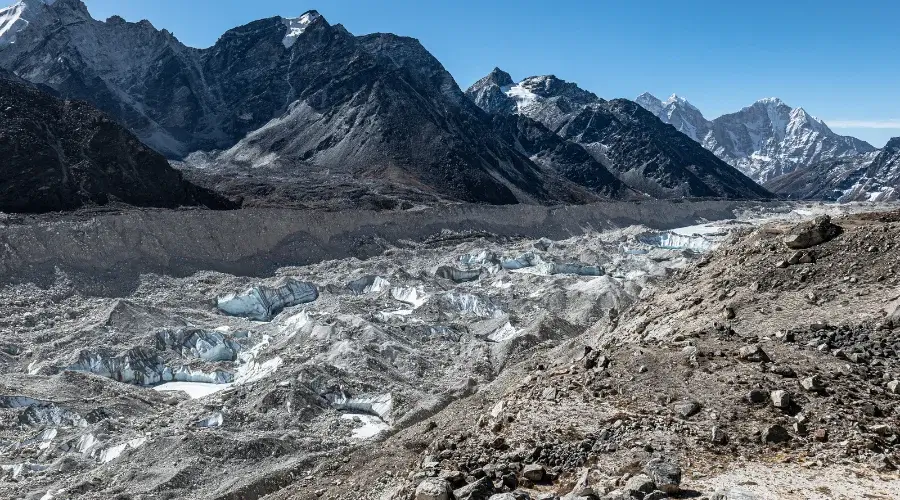
Additional Tips
- Group Size: The helicopter can accommodate 5 passengers and a pilot from the Gorakshep region. However, if you want a private helicopter, you can fly back via Kala Patthar. Only 3 people can be accommodated, including the pilot.
- Weather Considerations: Helicopter flights are subject to weather conditions, so be prepared for potential delays.
Reviews
A few weeks ago, in March 2024, I finished my trekking to the everest base camp with a Himalayan masters and my guide bash Himalayan masters I had such a positive experience with this team; from the beginning, sandip helped me to make the best itinerary for me at an affordable price and with a swift response, dealing with Sandip is always great. He’s such an experienced operator and a great leader of the company.
I completed my 9-day trek to Everest base camp and returned by helicopter with my guide Bashu. He’s such a professional leader who helped me to reach the base camp; without his support and motivation, I don’t think I would be able to reach the base camp. The service from the Himalayan masters is top-notch; I get my first helicopter ride from the Gorakshep to Lukla and back in Kathamndu. The accommodations and food are remarkable in time—such a quality operator. I will be back again and trek with this company once again.
Alex SelickUSA 🇺🇸
FAQs
How do people return from Everest Base Camp?
There are two options for returning from Everest Base Camp. You can either choose to trek back the same route you took while going to the base camp, fly back on a helicopter to Lukla and then to Kathmandu by flight, or directly fly back to Kathmandu on a helicopter.
How much does a helicopter rescue cost on Everest?
Can I trek the Everest Base Camp trek without a guide?
Why can't you fly up Everest?
How much weight do you need to carry to Everest Base Camp?
Are there 2 base camps on Everest?
How many days do you need to base camp on the Everest?
Can you get to Everest Base Camp without flying to Lukla?
How much money should I take on Everest Base Camp Trek?
Can a helicopter rescue you from Everest?
Are helicopter tours bumpy?
How safe are helicopter tours?
Is the Everest Base Camp trek tough?
Are helicopter tours cold?
How much is a helicopter ride to the top of Mount Everest?
Is the Mount Everest ride scary?
Is the Everest Base Camp trek busy?
What does the Everest Base Camp Trek cost?
Speak to an Expert





Sandip Dhungana
Nepal 🇳🇵
Whatsapp: +977-9823636377
Speak to an Expert





Sandip Dhungana
Nepal 🇳🇵
Whatsapp: +977-9823636377



